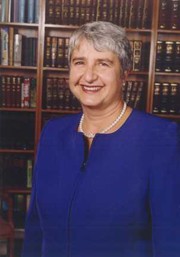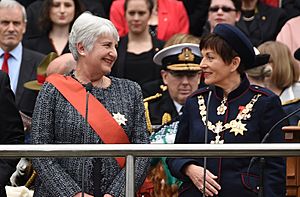Sian Elias facts for kids
Quick facts for kids
The Right Honourable Dame
Sian Elias
GNZM KC
|
|
|---|---|
 |
|
| 12th Chief Justice of New Zealand | |
| In office 17 May 1999 – 13 March 2019 |
|
| Nominated by | Jenny Shipley |
| Appointed by | Sir Michael Hardie Boys |
| Preceded by | Thomas Eichelbaum |
| Succeeded by | Helen Winkelmann |
| Administrator of the Government (Acting Governor-General) |
|
| In office 31 August 2016 – 28 September 2016 |
|
| Monarch | Elizabeth II |
| Prime Minister | John Key |
| In office 23 August 2011 – 31 August 2011 |
|
| Monarch | Elizabeth II |
| Prime Minister | John Key |
| In office 4 August 2006 – 23 August 2006 |
|
| Monarch | Elizabeth II |
| Prime Minister | Helen Clark |
| In office 22 March 2001 – 4 April 2001 |
|
| Monarch | Elizabeth II |
| Prime Minister | Helen Clark |
| Personal details | |
| Born |
Sian Seerpoohi Elias
13 March 1949 London, England |
| Spouse | Hugh Fletcher |
| Children | Two |
| Alma mater | University of Auckland Stanford Law School |
| Profession | Barrister |
| Awards | New Zealand 1990 Commemoration Medal |
Dame Sian Seerpoohi Elias (born 13 March 1949) is a very important person in New Zealand's legal history. She was the 12th Chief Justice of New Zealand, which means she was the most senior judge in the country.
As Chief Justice, she led the Supreme Court of New Zealand. She also sometimes acted as the Administrator of the Government. This role is like being the acting Governor-General when the actual Governor-General is away or unable to do their job.
Contents
Early Life and Education
Sian Elias was born in London, England, in 1949. Her father was Armenian and her mother was Welsh. She moved to New Zealand in 1952 with her family.
She went to Diocesan School for Girls in Auckland. Later, she studied law at the University of Auckland, finishing her degree in 1970. She then continued her studies at Stanford University in the United States.
After her studies, she started working at a law firm in Auckland in 1972. Three years later, she became a barrister. A barrister is a type of lawyer who represents people in court.
Early Career in Law
From 1984 to 1988, Elias worked as a Law Commissioner. This role involves helping to improve and update New Zealand's laws. She also became well-known for her work on cases related to the Treaty of Waitangi. The Treaty of Waitangi is a very important agreement in New Zealand's history.
In 1990, she received the New Zealand 1990 Commemoration Medal for her services to the country. In 1988, she and Lowell Goddard became the first women in New Zealand to be named Queen's Counsel. This is a special title given to experienced lawyers.
In 1995, Elias became a judge of the High Court of New Zealand. She also sometimes served on the New Zealand Court of Appeal, which hears appeals from lower courts.
Chief Justice of New Zealand

On 17 May 1999, Sian Elias made history. She was sworn in as the Chief Justice of New Zealand. She was the very first woman to hold this important position.
Later that year, in the 1999 Queen's Birthday Honours, she was given the title of Dame Grand Companion of the New Zealand Order of Merit. This is a high honour that recognizes her significant contributions.
Role as Administrator of the Government
One of the Chief Justice's special duties is to act as the Administrator of the Government. This happens when the Governor-General cannot do their job. This might be because the position is empty, or the Governor-General is sick or out of the country.
Dame Sian Elias served as the Administrator of the Government several times. For example, she held this role from 22 March to 4 April 2001. She also served from 4 August to 23 August 2006, from 23 August to 31 August 2011, and from 31 August to 28 September 2016. She stepped in whenever needed to ensure the country's government continued to run smoothly.
Supporting Māori Treaty Claims
Dame Sian Elias played a key role in cases related to the Treaty of Waitangi. In 1984, she helped Ngāneko Minhinnick with a claim about the Manukau Harbour to the Waitangi Tribunal. The Waitangi Tribunal looks into claims by Māori that the Treaty of Waitangi has been broken.
Her work on Treaty cases continued. She was involved in a case that stopped the government from selling radio frequencies. She also worked on a case that challenged the 1994 Māori electoral option. This option allowed Māori to choose whether to vote in general electorates or special Māori electorates.
In June 2003, she was part of a very important case. This case suggested that the Māori Land Court might be able to give Māori groups ownership of the foreshore and seabed. The foreshore is the land between the high and low tide marks, and the seabed is the land under the sea. This case led to a lot of discussion and changes in New Zealand's political scene for about 18 months.
The "Blameless Babes" Speech
In July 2009, Dame Sian Elias gave a speech called "Blameless Babes." This speech was part of an annual event honouring Shirley Smith, a famous lawyer. The title came from a quote by Shirley Smith, who said that building more prisons isn't the only answer. She believed we need to understand *why* people break laws.
In her speech, Dame Sian talked about her concerns about prisons being too full. She also spoke about how politicians sometimes react too quickly to crime. She believed that New Zealand needed to look at the reasons behind why people commit crimes. She felt it was important to find solutions to these underlying problems.
She suggested that if New Zealand didn't address these root causes, the government might have to release people from prison early. Her comments were widely discussed in the news. The Minister of Justice at the time, Simon Power, said that her speech did not represent the government's policy.

